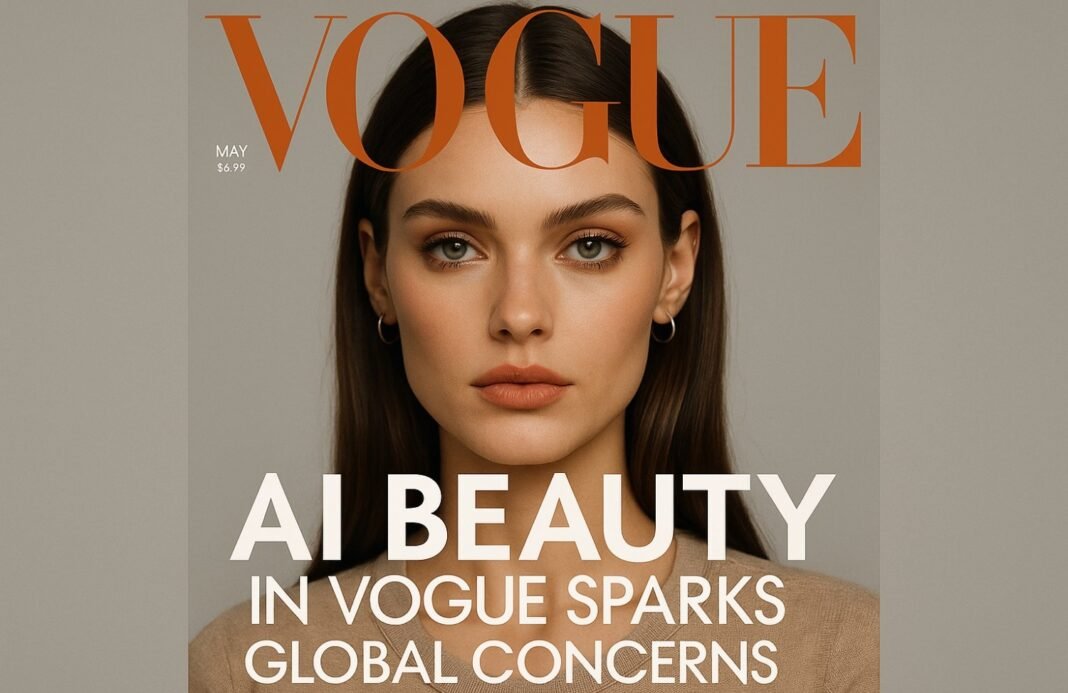The Rise of Artificial Beauty: Vogue Faces Backlash
In a groundbreaking yet controversial move, the August issue of Vogue features a Guess advertisement with an AI-generated model. The flawless blonde woman—dressed in a striped maxi dress and floral playsuit—might appear to be just another polished face in high fashion, but a small disclaimer in the corner reveals the truth: she isn’t real.
The model was created by Seraphinne Vallora, a company co-founded by Valentina Gonzalez and Andreea Petrescu. They were commissioned by Guess co-founder Paul Marciano, who selected one brunette and one blonde AI model from ten digital drafts. The resulting image, though striking, has reignited a storm of criticism across the fashion and tech worlds.
Unrealistic Ideals Made Perfectly Digital
The problem, critics say, is not just the use of AI—but what it represents. AI-generated models, like the one featured in Vogue, are created to be flawless. Unlike traditional models, they aren’t retouched versions of real people—they are built from scratch to embody an idealized beauty standard: young, thin, white, and symmetrical.
Felicity Hayward, a veteran plus-size model, called the campaign “lazy and cheap,” suggesting it undermines progress made toward diversity and inclusion. “These decisions erase real people from an industry that has fought hard for visibility,” she said.
The Cost of Synthetic Beauty
Beyond aesthetics, the implications run deep. AI modeling cuts out entire teams—models, photographers, stylists, makeup artists, and set crews. While Seraphinne Vallora claims it hires professionals for reference shoots, the company’s website promotes cost savings by eliminating many of these roles. As Sara Ziff of the Model Alliance warns, “This isn’t about innovation—it’s about slashing budgets at the expense of human labor.”
While the company argues that its work supplements rather than replaces real models, critics point out the economic and ethical gray areas. Many fear that as AI becomes more normalized in fashion, the demand for human talent will sharply decline.
Mental Health in the Age of Digital Perfection
Experts are also raising alarms about how AI models affect mental health. Vanessa Longley, CEO of the eating disorder charity Beat, said exposure to unrealistic AI-generated bodies could fuel body dissatisfaction and disordered eating. “These images look human but are designed to be perfect. That perfection is unattainable—and harmful,” she said.
The issue is magnified by poor transparency. In the UK, it is not legally required to label AI-generated content, and in the Guess ad, the disclaimer was small and easy to miss. Tech entrepreneur and former model Sinead Bovell called this “exceptionally problematic,” warning that young people are increasingly seeking surgery to match digital faces. “We are no longer just comparing ourselves to airbrushed humans—we’re comparing ourselves to non-existent ones,” she said.
Technology Reflects Bias, Then Reinforces It
Even the creators of Seraphinne Vallora acknowledge that engagement on their Instagram favors Eurocentric, conventional beauty. Gonzalez admitted that when the company posts images of AI models with diverse features or different skin tones, engagement plummets. “We are a business,” she said, “and we post what draws attention.”
The company has yet to produce a plus-size AI model, citing technological limitations. For many, that excuse underscores how AI is replicating—and amplifying—societal bias rather than challenging it.
Dove’s 2024 campaign illustrated the problem vividly: an AI image generator, asked to create the world’s most beautiful woman, produced rows of nearly identical faces—thin, white, blonde, and blue-eyed. The resemblance to the Guess AI model was uncanny.
A Call for Global Regulation
This moment signals more than a shift in fashion—it highlights a global issue. As AI continues to automate industries from tech to entertainment, the need for oversight becomes urgent. What begins as a trend in magazines can ripple across economies and cultures.
There’s growing consensus that a global framework must be established to govern the use of AI—one that addresses ethical standards, labor protections, and the psychological impact of synthetic media.
The question is no longer just “does it look real?” but “at what cost?” As artificial beauty becomes indistinguishable from reality, we must decide how much space machines should occupy in human industries—and who pays the price when they do







